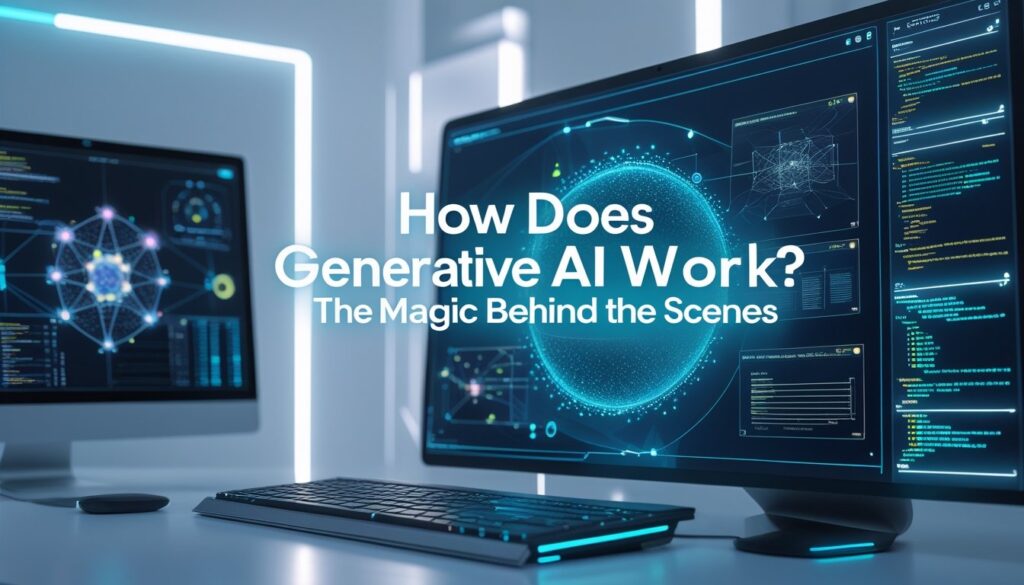Curious about Generative AI? This beginner’s guide explains what it is, how it works (LLMs, Diffusion Models), and its real-world uses in business, art, and beyond. Learn the benefits, risks, and future of this transformative technology.

More Than Just Hype
You’ve probably seen them—incredibly detailed images created from simple text prompts, poems written in the style of Shakespeare about modern problems, or even code snippets generated from a basic description. This isn’t science fiction; it’s Generative AI, and it’s rapidly moving from the research lab into our everyday lives.
But what exactly is Generative AI? Is it just a fancy tool for creating memes and art, or is it something more profound?
In short, Generative AI is a type of artificial intelligence that can create new, original content—like text, images, music, code, and even video—that didn’t exist before. It learns the underlying patterns from massive amounts of data and then uses this knowledge to generate novel outputs.
This technology is poised to transform every industry, from marketing and software development to medicine and design. This guide will demystify Generative AI, break down how it works, explore its powerful applications, and discuss the critical challenges we must navigate as a society.
What is Generative AI? Beyond Simple Copying
Let’s clear up a common misconception first. Generative AI isn’t just copying and pasting from the internet. It’s not a sophisticated search engine.
Think of it like this: if you show a child thousands of pictures of cats, they eventually learn the abstract concept of “cat-ness.” They can then draw their own unique cat, one they’ve never seen before, complete with whiskers, a tail, and pointy ears. They’ve generated a new image based on a learned model.
Generative AI does the same thing, but at a scale and speed impossible for humans. It’s a subset of deep learning, which itself is a branch of machine learning.
- Traditional AI (Predictive AI): Analyzes data and makes predictions. (e.g., “Is this email spam?” or “Will this customer churn?”)
- Generative AI: Uses patterns to create brand new data. (e.g., “Write me a marketing email that doesn’t sound like spam,” or “Design a product that would prevent this customer from churning.”)
The “generative” part comes from its ability to produce something genuinely new, making it one of the most creative and disruptive branches of AI.
How Does Generative AI Work? The Magic Behind the Scenes

While the math is complex, the core concepts are understandable. Most of today’s impressive Generative AI models rely on a few key architectures:
1. Large Language Models (LLMs) and the Transformer Architecture
This is the technology behind ChatGPT, Google Gemini, and Claude. The breakthrough came with a 2017 Google research paper titled “Attention Is All You Need,” which introduced the Transformer architecture.
- The “Large” in LLM: These models are trained on terabytes of text data from books, articles, and websites—essentially a significant portion of the public internet.
- How it Learns: The model learns by playing a giant guessing game. It takes a sequence of words (e.g., “The cat sat on the…”) and tries to predict the next word (“mat”). By doing this trillions of times, it learns grammar, facts, reasoning abilities, and even writing styles.
- The “Attention” Mechanism: This is the secret sauce. It allows the model to weigh the importance of different words in a sentence. When you ask, “What is the capital of France?”, the model pays more “attention” to “capital” and “France” to provide the correct answer, “Paris.”
2. Diffusion Models: The Artists of the AI World
This is the primary technology behind image generators like Midjourney, DALL-E, and Stable Diffusion.
- The Process:
- Forward Diffusion (The “Noising” Process): The model takes a clear training image and gradually adds random noise to it, step by step, until it becomes complete static.
- Reverse Diffusion (The “Denoising” Process): The model is then trained to reverse this process. It learns how to take a completely random field of noise and, step by step, remove the noise to form a coherent image.
- Generation: When you give it a text prompt, it uses your description to guide the “denoising” process, sculpting a new image out of the noise based on what it has learned.
(Image suggestion: A simple diagram showing a clear picture of a cat -> turning into noise -> then being reconstructed step-by-step back into a cat.)
3. Generative Adversarial Networks (GANs)
GANs were the previous state-of-the-art for image generation and are still used today. They involve two neural networks competing against each other:
- The Generator: Tries to create fake data (e.g., a photo of a human face).
- The Discriminator: Tries to distinguish between real data (from a training set) and the fake data from the Generator.
They are locked in a contest. The Generator gets better at creating realistic fakes to fool the Discriminator, and the Discriminator gets better at spotting fakes. This competition rapidly improves the quality of the generated output.
The Real-World Power of Generative AI: Use Cases Across Industries
This isn’t just theoretical. Businesses and creators are already leveraging Generative AI to drive efficiency and innovation.
Content Creation & Marketing
- Blog Posts & Social Media: Tools like Jasper and Copy.ai can help generate draft blog posts, social media captions, and ad copy, freeing up human writers for strategy and editing.
- Personalized Email Campaigns: Generate thousands of unique, personalized email variations for marketing campaigns.
- Voiceovers and Audio: Generate human-like voiceovers for videos in multiple languages and accents.
Software Development & IT
- Code Generation: GitHub Copilot acts as an AI pair programmer, suggesting whole lines of code and functions as developers type, dramatically speeding up development.
- Bug Fixing and Explanation: AI can not only identify bugs but also suggest fixes and explain complex pieces of legacy code.
- Technical Documentation: Automatically generate and update technical documentation from code comments.
Design & Visual Arts
- Concept Art and Storyboarding: Designers can rapidly generate hundreds of concepts for characters, environments, or products to spark inspiration.
- Marketing Assets: Create unique images for blog posts, social media, and ads without needing a photoshoot or extensive graphic design skills.
- Interior and Architectural Design: Generate realistic renders of room designs based on a text description.
Business Operations & Customer Service
- AI Chatbots and Virtual Agents: Power next-generation customer service bots that can understand complex queries and provide helpful, contextual answers.
- Synthetic Data Generation: Create artificial data that mimics real-world data for software testing and training other AI models, which is crucial for protecting privacy.
- Summarization: Instantly summarize long documents, meeting transcripts, or research papers into key bullet points.
Science & Healthcare
- Drug Discovery: Generate molecular structures for new potential drugs and predict their effectiveness, significantly shortening the initial research phase.
- Medical Imaging: Enhance low-quality medical scans or even generate synthetic medical images to help train diagnostic AI models where real data is scarce.
The Flip Side: Challenges, Risks, and Ethical Considerations

The power of Generative AI comes with significant responsibilities and risks that we are only beginning to grapple with.
- Hallucinations and Inaccuracy: LLMs can generate plausible-sounding but completely false information. It’s crucial to fact-check all AI-generated content, as the model is designed to be persuasive, not truthful.
- Bias and Fairness: Since these models are trained on data from the internet, they can inherit and even amplify societal biases related to race, gender, and culture.
- Intellectual Property and Copyright: Who owns the output of a Generative AI? Is the training data used without permission a form of copyright infringement? These are major, unresolved legal questions.
- Job Displacement: As with any automation technology, there is a real concern about AI displacing jobs in content creation, customer service, and even coding. The key will be to adapt and use AI as a tool to augment human skills.
- Misinformation and Deepfakes: Malicious actors can use this technology to create convincing fake news, propaganda, and “deepfake” videos, posing a threat to personal reputations and democratic processes.
The Future of Generative AI: What’s Next?
We are still in the early innings of this technological revolution. Here’s what we can expect on the horizon:
- Multimodal Models as Standard: The next generation of models will seamlessly combine text, image, audio, and video. You’ll be able to ask a model, “Create a video of a dog surfing on a Saturn’s ring, set to 80s synth-pop music,” and it will.
- Increased Personalization: AI will know your personal style and preferences, acting as a true creative partner tailored to you.
- The Rise of “Small Language Models”: While LLMs are massive, there’s a growing trend towards smaller, more efficient models that can run on personal devices, offering greater privacy and speed.
- Stronger Governance and Ethics: We will see the development of more robust tools for AI detection, watermarking, and ethical guidelines to ensure this technology is used responsibly.
A Tool for Human Amplification

Generative AI is not a replacement for human creativity, judgment, and expertise. Instead, it is a powerful amplifier. It can handle the tedious, time-consuming work of drafting, ideating, and coding, freeing up humans to do what we do best: strategize, empathize, edit, and make nuanced ethical decisions.
The key to success in this new era is not to fear the technology but to understand it. Learn its capabilities, be aware of its limitations, and critically evaluate its outputs.
The future won’t be built by AI alone; it will be built by humans working intelligently with AI.
